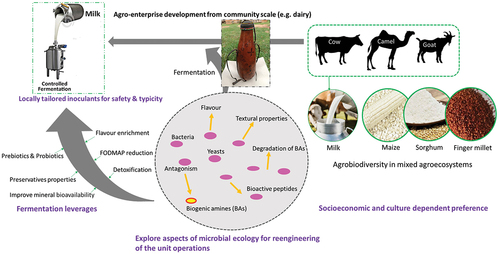Figures & data
Table 1. Kenyan traditional fermented foods and beverages and their associated microbiota.
Figure 1. Diversity of plant species for which chopped stems are used to prepare glowing splints for sooting the fermentation vessel (calabash/gourd) inner surface. A case example of the gourd smoking in progress (shown in the centre) with the charcoal from the burning wood. This process is repeated until the inside is smooth and even. After it has been suitably sooted, the extra dust from the charcoal is gently removed. The gourd is now regarded as ready for usage and is covered and left to cool.

Figure 2. Bacteria and yeast genera that commonly co-occur in five major Kenyan traditional fermented foods. Microorganisms widely used as probiotics mostly belong to the genera Lactobacillus for bacteria and the yeast Saccharomyces.[Citation102,Citation103] in the five fermented foods identified, the LAB and the yeast Saccharomyces have a predominant co-occurrence despite varied substrate and processing variations that may shape microbial ecology attributes that influence mechanisms of microbial community formation.[Citation104] LAB and yeast co-exist synergistically in diverse traditional fermented foods by stimulating their growth and survival.[Citation64,Citation105] the co-occurrence and anticipated beneficial interactions of LAB and yeast across the five foods give credence to their distinctive probiotic viability while in their native forms and that, processing optimization through microbial ecology principles would positively influence valorisation prospects.[Citation17,Citation104,Citation105] Microorganisms commonly considered probiotics, and characterized and/or co-occurring in the five foods: Kule naota; Lactobacillus plantarum, Lactobacillus paracasei, Lactobacillus rhamnosus, Lactobacillus acidophilus, isolates of Lactococcus lactis and Saccharomyces cerevisiae. Mursik; Lactobacillus plantarum, Lactobacillus curvatus, Lactobacillus fermentum, Lactobacillus brevis, Lactobacillus casei as well as Lactococcus lactis, Enterococcus faecium, Leuconostoc mesenteroides and Saccharomyces cerevisiae. Amabere amaruranu; Lactobacillus plantarum, Lactobacillus bulgaricus, Lactococcus lactis, Leuconostoc mesenteroides, Streptococcus thermophilus and Saccharomyces cerevisiae. Suusac; Lactobacillus plantarum, Lactobacillus curvatus, Leuconostoc mesenteroides and Saccharomyces cerevisiae. Mnazi: Lactobacillus plantarum, Lactobacillus paracasei, Lactococcus lactis, and Saccharomyces cerevisiae. Strain specific data to justify precise probiotic traits is scanty, there is need for further investigations to delineate the subspecies and genetic differences if any and where necessary. Methods such as comparative genomics analysis have the potential to provide insights into the genetic variation and evolutionary relationships among subspecies, while also facilitating the precise detection of strains that display dual phenotypes.[Citation105–108]
![Figure 2. Bacteria and yeast genera that commonly co-occur in five major Kenyan traditional fermented foods. Microorganisms widely used as probiotics mostly belong to the genera Lactobacillus for bacteria and the yeast Saccharomyces.[Citation102,Citation103] in the five fermented foods identified, the LAB and the yeast Saccharomyces have a predominant co-occurrence despite varied substrate and processing variations that may shape microbial ecology attributes that influence mechanisms of microbial community formation.[Citation104] LAB and yeast co-exist synergistically in diverse traditional fermented foods by stimulating their growth and survival.[Citation64,Citation105] the co-occurrence and anticipated beneficial interactions of LAB and yeast across the five foods give credence to their distinctive probiotic viability while in their native forms and that, processing optimization through microbial ecology principles would positively influence valorisation prospects.[Citation17,Citation104,Citation105] Microorganisms commonly considered probiotics, and characterized and/or co-occurring in the five foods: Kule naota; Lactobacillus plantarum, Lactobacillus paracasei, Lactobacillus rhamnosus, Lactobacillus acidophilus, isolates of Lactococcus lactis and Saccharomyces cerevisiae. Mursik; Lactobacillus plantarum, Lactobacillus curvatus, Lactobacillus fermentum, Lactobacillus brevis, Lactobacillus casei as well as Lactococcus lactis, Enterococcus faecium, Leuconostoc mesenteroides and Saccharomyces cerevisiae. Amabere amaruranu; Lactobacillus plantarum, Lactobacillus bulgaricus, Lactococcus lactis, Leuconostoc mesenteroides, Streptococcus thermophilus and Saccharomyces cerevisiae. Suusac; Lactobacillus plantarum, Lactobacillus curvatus, Leuconostoc mesenteroides and Saccharomyces cerevisiae. Mnazi: Lactobacillus plantarum, Lactobacillus paracasei, Lactococcus lactis, and Saccharomyces cerevisiae. Strain specific data to justify precise probiotic traits is scanty, there is need for further investigations to delineate the subspecies and genetic differences if any and where necessary. Methods such as comparative genomics analysis have the potential to provide insights into the genetic variation and evolutionary relationships among subspecies, while also facilitating the precise detection of strains that display dual phenotypes.[Citation105–108]](/cms/asset/3040b6e0-ca99-4b2c-9837-62dfc8b6cdf5/lfri_a_2355992_f0002_oc.jpg)
Figure 3. A case of rural Kenya experience in mursik production and consumption: (a) an enterprising local farmer who produces calabashes/gourd bottles for sale to the community and beyond, due to its high demand for use in the production of indigenous fermented milk (mursik). (b) a demonstration of how the calabash/gourd is coated on the inside by smoking with special tree species locally used for flavour and alluded medicinal benefits. (c) Fermented mursik in a calabash ready for consumption. (d) Mursik with the dark effect due to smoking is aliquoted from the calabash to an open container for further mixing before consumption to ensure the smoking effect from the fermentation process done in the calabash is properly mixed and for evenness.

Figure 4. Schematic model for interlinked microbial ecology of natural fermentation research and food systems policy action cues in traditional fermented foods: understanding food products’ preference and perception (e.g. cereal or milk-based and alcoholic or non-alcoholic) depending on the cultural context of the communities; investigating aspects of the microbial ecology of the traditional fermented foods (e.g. studying the diverse bacteria, yeasts, and moulds that contribute to the fermentation process) and its role in the substrates utilized; microbial ecology studies can assist in identifying biomarkers (measurable indicator of some biological state or condition) for assessing fermented food quality and aid in the development of optimal ecology driven process design to upscale and standardize fermentation while being cognizant of intertwined biocultural diversity (for instance preservation of organoleptic properties). In the case of microbial ecology-driven biomarkers identification, some microbial metabolites, enzymes, and proteins can be utilized to evaluate whether a food product has been properly fermented or contains harmful microbes. As an effect of the interlaced actions, stimulate agro-enterprise development (e.g. shift from calabash/ gourd fermentation (top centre) to milk grade controlled fermentation tank (top left) with a touch of typicity).

